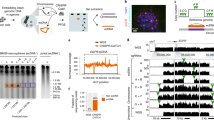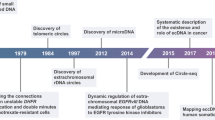Abstract
In previous work1, several methotrexate (MTX)-resistant variants were isolated frm the human cell line HeLa BU25, which exhibited a high degree of dihydrofolate (DHFR) gene amplification (estimated to be 250- to 300-fold)1,2. These variants did not contain any chromosome with a homogeneously staining region (HSR) and exhibited only a small average number of minute chromosomes per cell: these two types of karyotypic abnormalities generally accompany selective gene amplification3. We now report that structures containing amplified DHFR genes in one of these variants (HeLa BU25-10B3) can be isolated by pulsed-field gradient or field-inversion gel electrophoresis as homogeneous DNA molecules of ∼650 kilobases (kb). Electron microscopy of metaphase spreads from these cells reveals chromatin fibres with a similar DNA content, which are probably related to the above elements. These represent a novel type of extrachromosomal structures in mammalian cells.
This is a preview of subscription content, access via your institution
Access options
Subscribe to this journal
Receive 51 print issues and online access
$199.00 per year
only $3.90 per issue
Buy this article
- Purchase on Springer Link
- Instant access to full article PDF
Prices may be subject to local taxes which are calculated during checkout
Similar content being viewed by others
References
Masters, J., Keeley, B., Gay, H. & Attardi, G. Molec. cell. Biol. 2, 498–507 (1982).
Morandi, C., Masters, J. N., Mottes, M. & Attardi, G. J. molec. Biol. 156, 583–607 (1982).
Stark, G. R. & Wahl, G. M. A. Rev. Biochem. 53, 447–491 (1984).
Maurer, B. J., Barker, P. E., Masters, J. N., Ruddle, F. H. & Attardi, G. Proc. natn. Acad. Sci. U.S.A 81, 1484–1488 (1984).
Human Gene Mapping 8 (1985): Eighth International Workshop on Human Gene Mapping. Cytogenet. Cell Genet. 40, Nos. 1–4 (1985).
Schwartz, D. C. & Cantor, C. R. Cell 37, 67–75 (1984).
Carle, G. F. & Olson, M. V. Nucleic Acids Res. 12, 5647–5664 (1984).
Carle, G. F., Frank, M. & Olson, M. V. Science 232, 65–68 (1986).
Carle, G. F. & Olson, M. V. Proc. natn. Acad. Sci U.S.A. 82, 3756–3760 (1985).
Van der Ploeg, L. H. T., Schwartz, D. C., Cantor, C. R. & Borst, P. Cell 37, 77–84 (1984).
Kemp, D. J. et al. Nature 315, 347–350 (1985).
Garvey, E. P. & Santi, D. V. Science 233, 535–540 (1986).
Hamkalo, B. A., Farnham, P. J., Johnston, R. & Schimke, R. T. Proc. natn. Acad. Sci. U.S.A. 82, 1126–1130 (1985).
Finch, J. T. & Klug, A. Proc. natn. Acad. Sci. U.S.A. 73, 1897–1901 (1976).
Author information
Authors and Affiliations
Rights and permissions
About this article
Cite this article
Maurer, B., Lai, E., Hamkalo, B. et al. Novel submicroscopic extrachromosomal elements containing amplified genes in human cells. Nature 327, 434–437 (1987). https://doi.org/10.1038/327434a0
Received:
Accepted:
Issue Date:
DOI: https://doi.org/10.1038/327434a0
This article is cited by
-
Life of double minutes: generation, maintenance, and elimination
Chromosoma (2022)
-
DNA copy number amplification profiling of human neoplasms
Oncogene (2006)
-
Amplification of the ABL gene in T-cell acute lymphoblastic leukemia
Leukemia (2004)
-
Fusion of NUP214 to ABL1 on amplified episomes in T-cell acute lymphoblastic leukemia
Nature Genetics (2004)
-
Murine pancreatic tumor cell line TD2 bears the characteristic pattern of genetic changes with two independently amplified gene loci
Oncogene (2003)
Comments
By submitting a comment you agree to abide by our Terms and Community Guidelines. If you find something abusive or that does not comply with our terms or guidelines please flag it as inappropriate.



